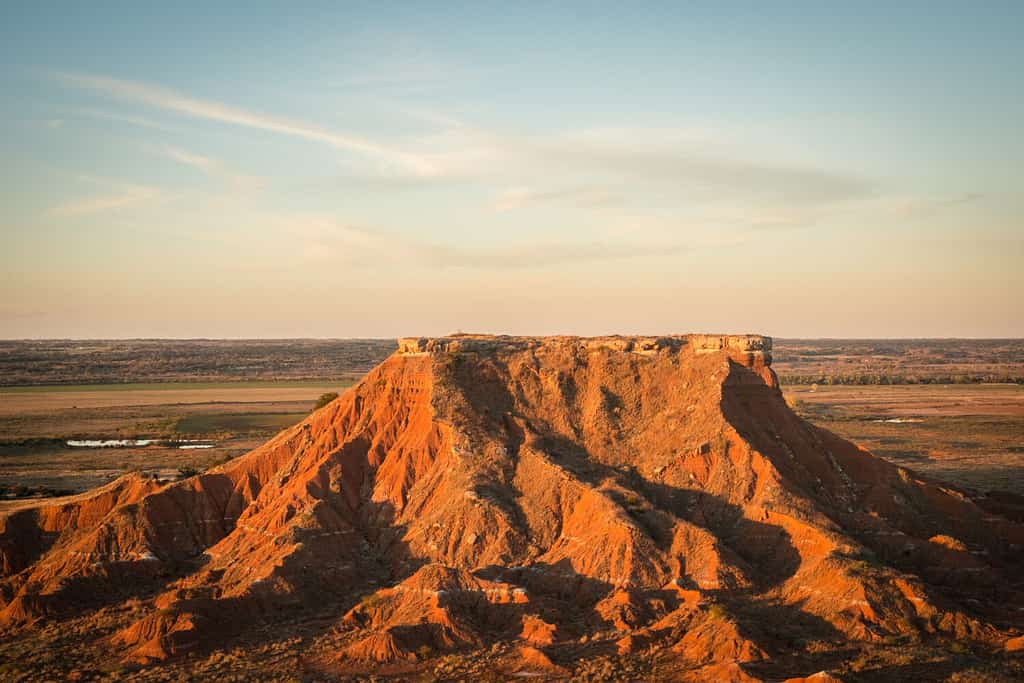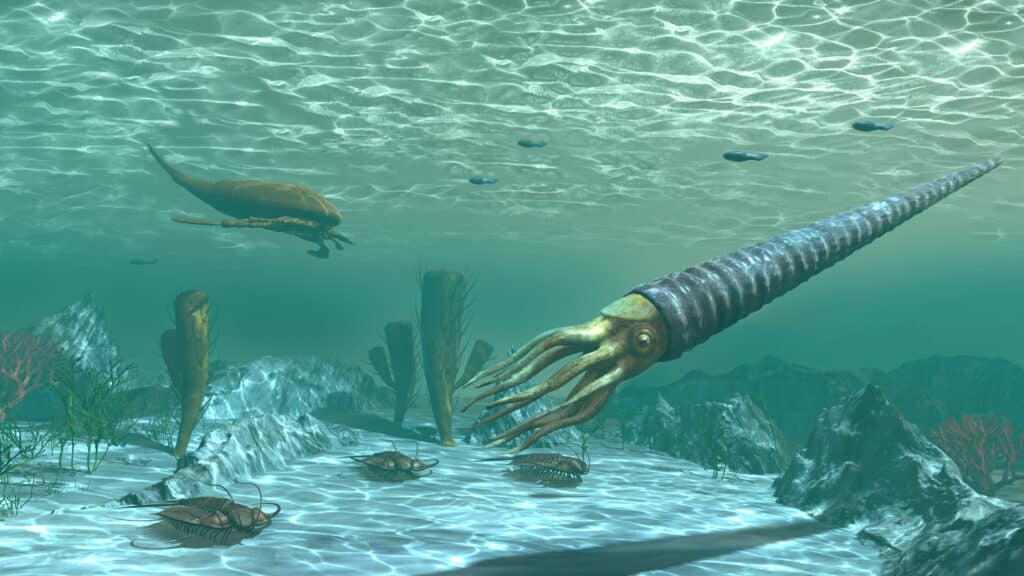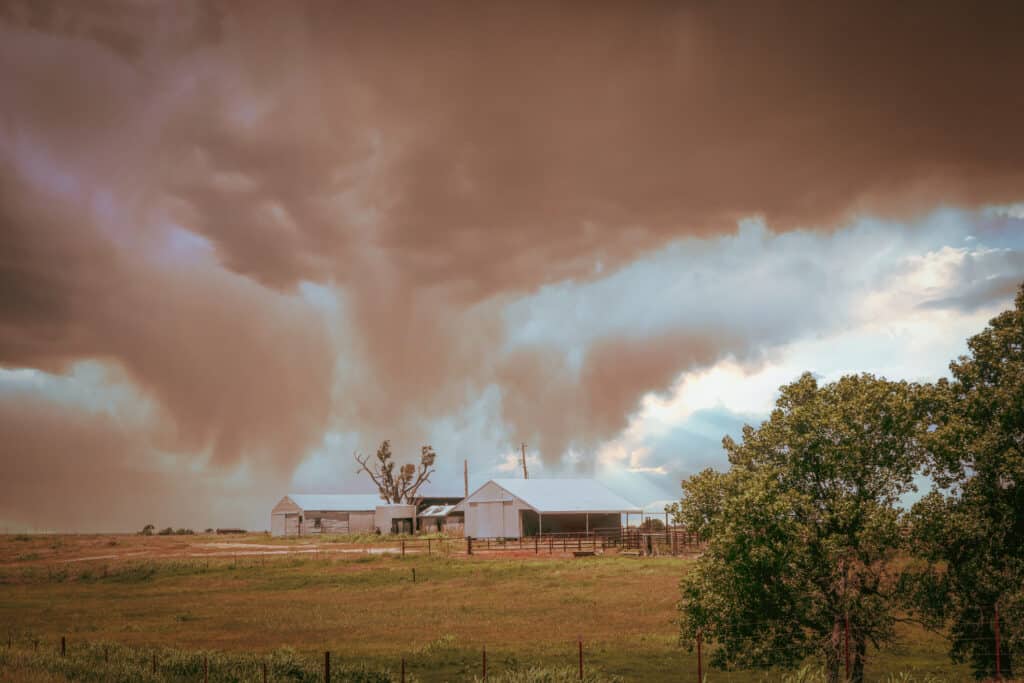If you ever find yourself driving through the little town of Ames, Oklahoma (population 239) and think nothing exciting could ever happen there, think again. Ames was ground zero for the biggest impact crater in Oklahoma. About 470 million years ago, a meteor nearly a mile in diameter slammed into the Earth at supersonic speeds, leaving behind a crater 10 miles across. The evidence of it is hidden deep underground, beneath 9,000 feet of sediment. But due to drilling in the area, scientists know it’s there. Just like they know that the cosmos is full of comets, asteroids, and meteors that could strike with apocalyptic consequences. As we explore the biggest impact crater in Oklahoma, we’ll uncover how life would be affected if a similar meteor struck today.

Glass Mountain is near Enid, Oklahoma, a city of 51,000 that is about 30 miles from the Ames crater site.
©Sara Armas/Shutterstock.com
Oklahoma in 470 million B.C.
The Ames crater was formed about 470 million years ago in a geologic epoch called the Middle Ordovician. This era came after the Cambrian Period and before the Silurian. During the so-called “Cambrian Explosion,” a large number of new lifeforms appeared within a relatively short time, geologically speaking. The Ordovician was also a time of rapid diversification of species, such as mollusks, arthropods, the first land plants, and more advanced forms of fish, including those with jaws. During the Ordovician, meteors hit the Earth about 100 times more frequently than they do today. Impacts like this may have been part of the mass extinction event that happened at the end of this period and the beginning of the Silurian.

Marine life was abundant and increasingly diversified during the Ordovician Period.
©Esteban De Armas/Shutterstock.com
Wildlife in Oklahoma Today
A lot has changed in the habitats of Oklahoma since prehistoric times. Here are some of the species native to the area today:
Birds and Fish
Oklahoma today is rich in wildlife. It is a wintering ground for many species of migratory birds. The state has a large number of waterfowl like swans, ducks, geese, cranes, pelicans, storks, and coots. Songbirds such as cardinals, warblers, wrens, orioles, finches, robins, and bluebirds live in large numbers in the state. Some of the birds of prey found there are eagles, hawks, owls, falcons, ospreys, and vultures. The state has over 177 species of fish, like bass, catfish, chubs, gars, perch, shiners, sturgeons, sunfish, and trout.
Mammals
Small mammal species in Oklahoma include mice, kangaroo rats, voles, squirrels, chipmunks, prairie dogs, gophers, porcupines, opossums, nutria, rabbits, skunks, armadillos, weasels, mink, ferrets, and badgers. Large mammals in Oklahoma include bison, deer, elk, pronghorn antelope, and invasive feral hogs as well as predators like the bobcat, coyote, several species of fox, and even black bears.
Livestock
In addition to wildlife, Oklahoma is a farming and ranching state with enormous numbers of livestock. Beef cattle, hogs, sheep, and poultry are the most commonly farmed animals there. Oklahoma is fifth in the nation in cattle and calf production, 10th in hog production, and produces 933 million eggs a year!

Prairie dogs are indigenous to Oklahoma. They have an endearing habit of kissing to identify one another.
©Nick Fox/Shutterstock.com
A Day When Ames Was Not OK
During the Ordovician, a meteor struck present day Ames, OK with an explosion big enough to leave behind a 10-mile-wide crater. How big was the meteor? It’s hard to say because there are so many variables. Was the object solid metal and rock, or a loose “snowball” of dust and ice similar to a comet? How fast was it moving and at what angle? Did it impact a body of water or land, and what kinds of rock layers were under the impact site?
We can’t know any of these answers for certain. However, taking some average data from a variety of impacts, it’s possible to generalize that the Ames meteor may have been nearly a mile in diameter and possibly created a mega-explosion larger than any existing nuclear weapon could produce. The force of the impact would have been comparable to an earthquake measuring something like 12.4 on the Richter scale. For reference, the 2004 Indian Ocean earthquake that created a deadly tsunami measured about 9.2 on the Richter scale. The Earth-shattering force of the Ames meteor could have been 1,000 times stronger than that!

The Ames meteor hit Oklahoma with an explosion more powerful than any nuclear weapon ever built.
©iStock.com/RomoloTavani
What If It Happened Today?
If such an unspeakable catastrophe happened in the same place today, the blast wave would vaporize Ames and the surrounding area, including Enid and its 51,000 residents, some 30 miles away. As it punched through the atmosphere at supersonic speed, the meteor would violently push aside the air in a matter of seconds, creating a vacuum that would suck up the impact debris into the stratosphere. Gravity would bring back down molten rocks like ballistic missiles. They would fall across a wide area of the state and neighboring Kansas, setting off thousands of wildfires.
The smoke and ash from the initial impact and the resulting fires would be carried by prevailing winds. Within a matter of days, sunlight would be dimmed across much of the Northern Hemisphere until the ash slowly drifted back down to Earth. As big as this blast would be, it would not be large enough to end life on the planet. But it would devastate a large part of the Midwest and the sun-blocking cloud it created could have a cooling effect on the planet for months or longer.

A meteor impact in Oklahoma could darken the skies for weeks, months, or a year or more.
©iStock.com/Susan Vineyard
What Are the Chances?
All of this sounds really alarming, especially if you live in Ames, Enid, or the surrounding area! So let’s put it in perspective. Only one person in the United States has ever been hit by a meteor. In the 1950s, a nine-pound meteor punched through the roof of a house, bounced off a radio, and hit a woman in the thigh as she slept on her couch.
Meteors actually bombard the planet every day, but most are small enough to burn up in the atmosphere, unnoticed. Only once every 2000 years or so does a meteor the size of a football field hit the Earth. What about something the size of the Ames meteor? Well, that’s more of a once-in-50,000-years deal. Because people only live on about 15% of the Earth’s surface, any future meteor is most likely to hit an uninhabited area, like ocean, ice, desert, or steep mountains. You’re vastly more likely to be in danger from driving, falling down a flight of stairs, or eating a high-cholesterol diet.
The photo featured at the top of this post is © Triff/Shutterstock.com
Thank you for reading! Have some feedback for us? Contact the AZ Animals editorial team.







